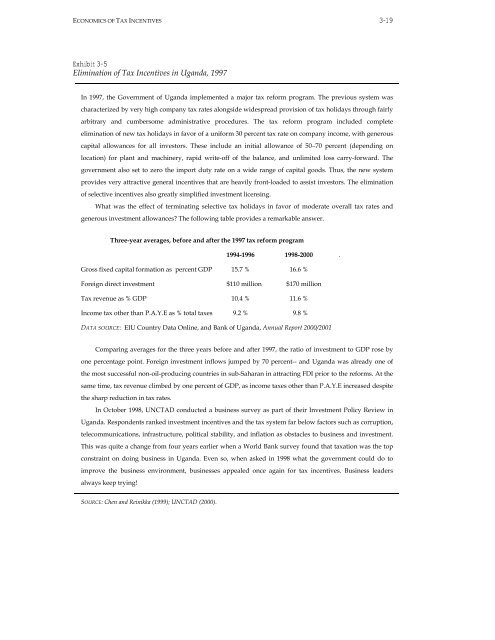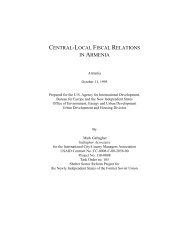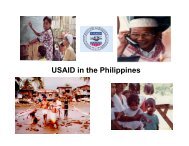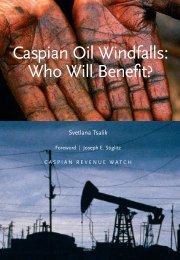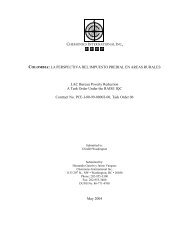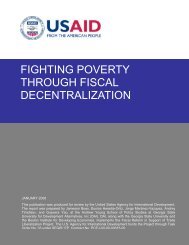Effectiveness and Economic Impact of Tax Incentives in the SADC ...
Effectiveness and Economic Impact of Tax Incentives in the SADC ...
Effectiveness and Economic Impact of Tax Incentives in the SADC ...
You also want an ePaper? Increase the reach of your titles
YUMPU automatically turns print PDFs into web optimized ePapers that Google loves.
ECONOMICS OF TAX INCENTIVES 3-19<br />
Exhibit 3-5<br />
Elim<strong>in</strong>ation <strong>of</strong> <strong>Tax</strong> <strong>Incentives</strong> <strong>in</strong> Ug<strong>and</strong>a, 1997<br />
In 1997, <strong>the</strong> Government <strong>of</strong> Ug<strong>and</strong>a implemented a major tax reform program. The previous system was<br />
characterized by very high company tax rates alongside widespread provision <strong>of</strong> tax holidays through fairly<br />
arbitrary <strong>and</strong> cumbersome adm<strong>in</strong>istrative procedures. The tax reform program <strong>in</strong>cluded complete<br />
elim<strong>in</strong>ation <strong>of</strong> new tax holidays <strong>in</strong> favor <strong>of</strong> a uniform 30 percent tax rate on company <strong>in</strong>come, with generous<br />
capital allowances for all <strong>in</strong>vestors. These <strong>in</strong>clude an <strong>in</strong>itial allowance <strong>of</strong> 50−70 percent (depend<strong>in</strong>g on<br />
location) for plant <strong>and</strong> mach<strong>in</strong>ery, rapid write-<strong>of</strong>f <strong>of</strong> <strong>the</strong> balance, <strong>and</strong> unlimited loss carry-forward. The<br />
government also set to zero <strong>the</strong> import duty rate on a wide range <strong>of</strong> capital goods. Thus, <strong>the</strong> new system<br />
provides very attractive general <strong>in</strong>centives that are heavily front-loaded to assist <strong>in</strong>vestors. The elim<strong>in</strong>ation<br />
<strong>of</strong> selective <strong>in</strong>centives also greatly simplified <strong>in</strong>vestment licens<strong>in</strong>g.<br />
What was <strong>the</strong> effect <strong>of</strong> term<strong>in</strong>at<strong>in</strong>g selective tax holidays <strong>in</strong> favor <strong>of</strong> moderate overall tax rates <strong>and</strong><br />
generous <strong>in</strong>vestment allowances? The follow<strong>in</strong>g table provides a remarkable answer.<br />
Three-year averages, before <strong>and</strong> after <strong>the</strong> 1997 tax reform program<br />
1994-1996 1998-2000 .<br />
Gross fixed capital formation as percent GDP 15.7 % 16.6 %<br />
Foreign direct <strong>in</strong>vestment $110 million $170 million<br />
<strong>Tax</strong> revenue as % GDP 10.4 % 11.6 %<br />
Income tax o<strong>the</strong>r than P.A.Y.E as % total taxes 9.2 % 9.8 %<br />
DATA SOURCE: EIU Country Data Onl<strong>in</strong>e, <strong>and</strong> Bank <strong>of</strong> Ug<strong>and</strong>a, Annual Report 2000/2001<br />
Compar<strong>in</strong>g averages for <strong>the</strong> three years before <strong>and</strong> after 1997, <strong>the</strong> ratio <strong>of</strong> <strong>in</strong>vestment to GDP rose by<br />
one percentage po<strong>in</strong>t. Foreign <strong>in</strong>vestment <strong>in</strong>flows jumped by 70 percent-- <strong>and</strong> Ug<strong>and</strong>a was already one <strong>of</strong><br />
<strong>the</strong> most successful non-oil-produc<strong>in</strong>g countries <strong>in</strong> sub-Saharan <strong>in</strong> attract<strong>in</strong>g FDI prior to <strong>the</strong> reforms. At <strong>the</strong><br />
same time, tax revenue climbed by one percent <strong>of</strong> GDP, as <strong>in</strong>come taxes o<strong>the</strong>r than P.A.Y.E <strong>in</strong>creased despite<br />
<strong>the</strong> sharp reduction <strong>in</strong> tax rates.<br />
In October 1998, UNCTAD conducted a bus<strong>in</strong>ess survey as part <strong>of</strong> <strong>the</strong>ir Investment Policy Review <strong>in</strong><br />
Ug<strong>and</strong>a. Respondents ranked <strong>in</strong>vestment <strong>in</strong>centives <strong>and</strong> <strong>the</strong> tax system far below factors such as corruption,<br />
telecommunications, <strong>in</strong>frastructure, political stability, <strong>and</strong> <strong>in</strong>flation as obstacles to bus<strong>in</strong>ess <strong>and</strong> <strong>in</strong>vestment.<br />
This was quite a change from four years earlier when a World Bank survey found that taxation was <strong>the</strong> top<br />
constra<strong>in</strong>t on do<strong>in</strong>g bus<strong>in</strong>ess <strong>in</strong> Ug<strong>and</strong>a. Even so, when asked <strong>in</strong> 1998 what <strong>the</strong> government could do to<br />
improve <strong>the</strong> bus<strong>in</strong>ess environment, bus<strong>in</strong>esses appealed once aga<strong>in</strong> for tax <strong>in</strong>centives. Bus<strong>in</strong>ess leaders<br />
always keep try<strong>in</strong>g!<br />
SOURCE: Chen <strong>and</strong> Re<strong>in</strong>ikka (1999); UNCTAD (2000).


